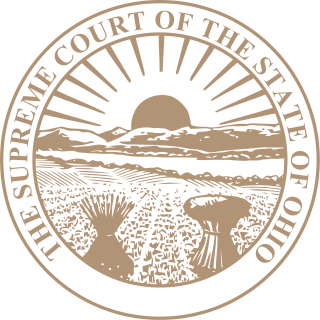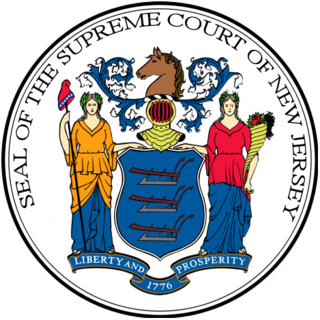Related Research Articles
The government of the U.S. state of Missouri is organized into the state government and local government, including county government, and city and municipal government.

The Governor of Indiana is the head of state and head of government of the state of Indiana. The governor is elected to a four-year term and is responsible for overseeing the day-to-day management of the functions of many agencies of the Indiana state government. The governor also shares power with other statewide executive officers, who manage other state government agencies. The governor works out of the Indiana Statehouse and holds official functions at the Indiana Governor's Residence in the state capital of Indianapolis.

The Supreme Court of the State of Ohio is the highest court in the U.S. state of Ohio, with final authority over interpretations of Ohio law and the Ohio Constitution. The court has seven members, a chief justice and six associate justices, each serving six-year terms and a total of 1550 other employees. Since 2004, the court has met in the Thomas J. Moyer Ohio Judicial Center on the east bank of the Scioto River in Downtown Columbus. Prior to 2004, the court met in the James A. Rhodes State Office Tower and earlier in the Judiciary Annex of the Ohio Statehouse.

The Supreme Court of Pennsylvania is the highest court in the Commonwealth of Pennsylvania's Unified Judicial System. It also claims to be the oldest appellate court in the United States, a claim that is disputed by the Massachusetts Supreme Judicial Court. The Supreme Court of Pennsylvania began in 1684 as the Provincial Court, and casual references to it as the "Supreme Court" of Pennsylvania were made official in 1722 upon its reorganization as an entity separate from the control of the royal governor. Today, the Supreme Court of Pennsylvania maintains a discretionary docket, meaning that the Court may choose which cases it accepts, with the exception of mandatory death penalty appeals, and certain appeals from the original jurisdiction of the Commonwealth Court. This discretion allows the Court to wield powerful influence on the formation and interpretation of Pennsylvania law.

The Supreme Court of New Jersey is the highest court in the U.S. state of New Jersey. In its current form, the Supreme Court of New Jersey is the final judicial authority on all cases in the state court system, including cases challenging the validity of state laws under the state constitution. It has the sole authority to prescribe and amend court rules and regulate the practice of law, and it is the arbiter and overseer of the decennial legislative redistricting. One of its former members, William J. Brennan Jr., became an Associate Justice of the Supreme Court of the United States.

The Supreme Court of Florida is the highest court in the U.S. state of Florida. It consists of seven members—the chief justice and six justices. Five members are chosen from five districts around the state to foster geographic diversity and two are selected at-large.

The Indiana Supreme Court, established by Article 7 of the Indiana Constitution, is the highest judicial authority in the state of Indiana. Located in Indianapolis, the Court's chambers are in the north wing of the Indiana Statehouse.

The Judiciary of Russia interprets and applies the law of Russia. It is defined under the Constitution and law with a hierarchical structure with the Constitutional Court and Supreme Court at the apex. The district courts are the primary criminal trial courts, and the regional courts are the primary appellate courts. The judiciary is governed by the All-Russian Congress of Judges and its Council of Judges, and its management is aided by the Judicial Department of the Supreme Court, the Judicial Qualification Collegia, the Ministry of Justice, and the various courts' chairpersons. And although there are many officers of the court, including jurors, the Prosecutor General remains the most powerful component of the Russian judicial system.
The chief justice of Ireland is the president of the Supreme Court of Ireland. The chief justice is the highest judicial office and most senior judge in Ireland. The role includes constitutional and administrative duties, in addition to taking part in ordinary judicial proceedings.

The Supreme Court of Oklahoma is a court of appeal for non-criminal cases, one of the two highest judicial bodies in the U.S. state of Oklahoma, and leads the judiciary of Oklahoma, the judicial branch of the government of Oklahoma.

The Supreme Court of Georgia is the highest judicial authority of the U.S. state of Georgia. The court was established in 1845 as a three-member panel. Since 1896, the justices have been elected by the people of the state. The justices are currently elected in statewide non-partisan elections for six-year terms, with any vacancies filled through an appointment by the Governor.
The Tennessee Plan is a system used to appoint and elect appellate court judges in Tennessee. The system requires candidates be selected by a nominating commission and therefore plays a significant role in the selection of the state's judiciary. It is largely patterned after the Missouri Plan, and an earlier version in Tennessee was called the Modified Missouri Plan.

The judiciary of Pakistan is a hierarchical system with two classes of courts: the superior judiciary and the subordinate judiciary. The superior judiciary is composed of the Supreme Court of Pakistan, the Federal Shariat Court and five High Courts, with the Supreme Court at the apex. There is a High Court for each of the four provinces as well as a High Court for the Islamabad Capital Territory. The Constitution of Pakistan entrusts the superior judiciary with the obligation to preserve, protect and defend the constitution. Neither the Supreme Court nor a High Court may exercise jurisdiction in relation to Tribal Areas, except otherwise provided for. The disputed regions of Azad Kashmir and Gilgit–Baltistan have separate court systems.

The government of the U.S. State of Oklahoma, established by the Oklahoma Constitution, is a republican democracy modeled after the federal government of the United States. The state government has three branches: the executive, legislative, and judicial. Through a system of separation of powers or "checks and balances," each of these branches has some authority to act on its own, some authority to regulate the other two branches, and has some of its own authority, in turn, regulated by the other branches.

The Oklahoma Judicial Nominating Commission is the judicial nominating commission of the U.S. state of Oklahoma. It selects potential justices and judges for gubernatorial appointments for judges for state appellate courts.

The Montana Supreme Court is the highest court of the Montana state court system in the U.S. state of Montana. It is established and its powers defined by Article VII of the 1972 Montana Constitution. It is primarily an appellate court which reviews civil and criminal decisions of Montana's trial courts of general jurisdiction and certain specialized legislative courts, only having original jurisdiction in a limited number of actions. The court's Chief Justice and six Associate Justices are elected by non-partisan, popular elections. The Montana Supreme Court meets in the Joseph P. Mazurek Building in Helena, Montana, the state's capital, an international style building completed in 1982 and named in the honor of former Montana Attorney General, Joseph P. Mazurek.

The New Mexico Supreme Court is the highest court in the U.S. state of New Mexico. It is established and its powers defined by Article VI of the New Mexico Constitution. It is primarily an appellate court which reviews civil and criminal decisions of New Mexico's trial courts of general jurisdiction and certain specialized legislative courts, only having original jurisdiction in a limited number of actions. It currently resides in the New Mexico Supreme Court Building in Santa Fe.

The Judiciary of California is defined under the California Constitution, law, and regulations as part of the Government of California. The judiciary has a hierarchical structure with the Supreme Court at the apex, California courts of appeal as the primary appellate courts, and the California superior courts as the primary trial courts. Its administration is effected by the Judicial Council and its staff, as well as the relatively autonomous courts. California uses a modified Missouri Plan method of appointing judges, whereby judges are nominally elected at the superior court level and appointed at higher levels, and are subject to retention elections.
The California Commission on Judicial Appointments is a body of the government of California established in its current form in 1979 that is responsible for reviewing and confirming justices appointed by the Governor of California to the Supreme Court of California and judges appointed by the Governor to the California Courts of Appeal. The commission consists of the Chief Justice, the Attorney General of California, and the state's senior presiding justice of the California Courts of Appeal. The senior Associate Justice fills the Chief Justice's spot on the commission when a new Chief Justice is nominated.

Montana District Courts are the state trial courts of general jurisdiction in the U.S. state of Montana. Montana District Courts have original jurisdiction over most civil cases, civil actions involving monetary claims against the state, criminal felony cases, naturalization proceedings, probate cases, and most writs. They may also hear certain special actions and proceedings, and oversee a narrowly-defined class of ballot issues. Montana District Courts also have limited appellate jurisdiction regarding cases that arise in Justice Courts, City Courts, and Municipal Courts as well as Judicial review of decisions by state administrative law tribunals that fall under the Montana Administrative Procedures Act.
References
- 1 2 3 "About the Commission". IN.gov. Archived from the original on 2008-07-25. Retrieved 2008-08-05.
- ↑ "Indiana Code". IN.gov. Retrieved 2008-08-05.
- ↑ Woollen, pp. 57 & 60
- ↑ Woollen, p. 83
